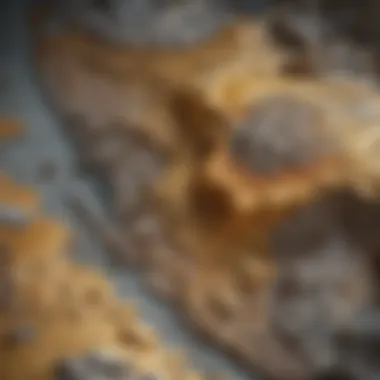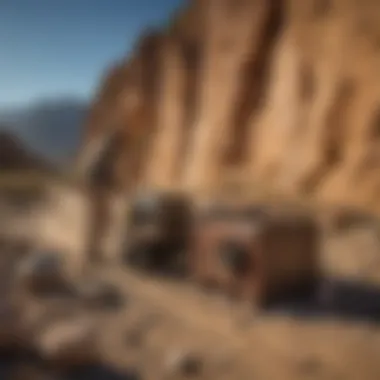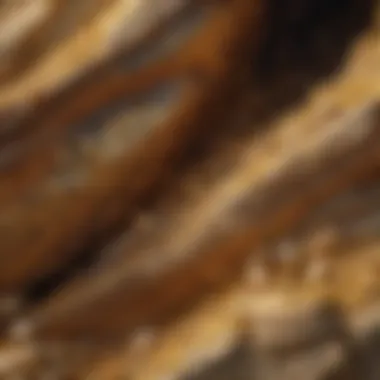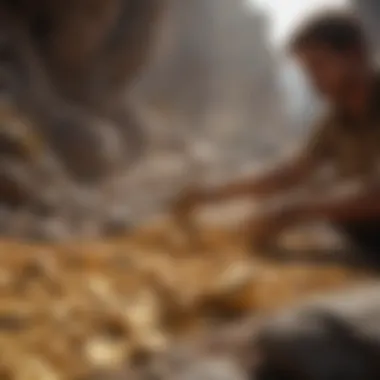Mastering the Art of Unveiling Gold Deposits in Rocks - A Complete Guide


Rock and Fossil Identification
In the thrilling quest for uncovering gold within rocks, a fundamental aspect lies in the adept identification of different rock types and the subtle fossils they may contain. By honing your observation skills and understanding the distinguishing features of various rocks and fossils, you pave the way for a successful prospecting journey. This process necessitates a careful examination of the subtle nuances that set each specimen apart. Chisel in hand, ready to uncover hidden treasures, enthusiasts delve into the intricate world of rock and fossil identification.
- Types of rocks and fossils: Delving deeper, we encounter a myriad of rock types, from sedimentary to igneous, each holding its own secrets within. Fossils too, with their silent tales of ancient times, add an element of mystery to the treasure hunt.
- Characteristics to look for: Aspiring prospectors are urged to scrutinize texture, color, and overall composition to distinguish significant rocks from mundane ones. For fossils, the patterns and imprints left behind can offer vital clues to the past.
- Tools for identification: Armed with magnifying lenses, rock hammers, and UV lights, collectors can unravel the hidden beauty within rocks. These tools act as extensions of the curious mind, aiding in the precise identification of key features.
Collecting Tips and Techniques
Amidst the rugged terrains and untamed landscapes, mastering the art of collecting becomes paramount. Best practices come to light, guiding enthusiasts towards fruitful discoveries while safeguarding the delicate balance of nature. The thrill of the hunt is magnified as prime collecting sites unveil their bounties, waiting to be unearthed. Patience and perseverance are virtues celebrated in this visceral journey as the techniques for safe extraction are put to practice, ensuring both specimen and environment remain unscathed.
- Best practices for collecting: From leaving no stone unturned to documenting findings meticulously, collectors adopt systematic approaches to enrich their discoveries. Respect for nature's creations forms the cornerstone of these practices, emphasizing ethical conduct in the pursuit of knowledge.
- Locating prime collecting sites: Through meticulous research and networking with fellow enthusiasts, one can uncover hidden gems nestled in remote locales. Geological maps and local insights serve as beacons, guiding the intrepid collector towards lands brimming with geological wonders.
- How to safely extract specimens: Equipped with knowledge on tools and techniques, collectors delicately extract specimens, mindful of preserving their integrity. Care and caution mark each step, ensuring the rocks and fossils are safeguarded for further study and admiration.
Preservation and Display
As the collection grows in richness and diversity, attention shifts towards preserving these geological marvels for posterity. Various techniques come into play, offering a glimpse into the art of conservation and the science of display. Rocks and fossils transition from mere objects to artifacts of immense historical and aesthetic value, speaking volumes about the Earth's tumultuous past.
- Techniques for preserving rocks and fossils: Through meticulous cleaning, stabilization, and protective measures, collectors ensure their specimens withstand the test of time. Coating applications, controlled environments, and archival storage methods stand as guardians of these precious remnants, preserving their allure for generations to come.
- Proper storage methods: From specialized cabinets to climate-controlled rooms, the storage of rocks and fossils demands careful consideration. Factors such as humidity levels, temperature fluctuations, and light exposure play pivotal roles in maintaining the integrity of the collection.
- Creative display ideas: With an artistic touch, collectors bring forth innovative display ideas that showcase their treasures in all their splendor. From themed exhibitions to interactive showcases, each display tells a unique narrative, inviting viewers to delve into the mysteries of Earth's past.
Geological Insights
Setting the stage for a deeper understanding of the Earth's historical tapestry, geological insights provide a profound context for appreciating rocks and fossils. From the forces that shaped our planet to the significance of key discoveries, this section delves into the very essence of Earth's evolution, narrated through the remnants that time has preserved.
- Geological formations and processes: Unraveling the intricate processes that have sculpted our landscapes, enthusiasts gain a newfound appreciation for the forces at play. From tectonic movements to climatic shifts, each rock and fossil bears witness to the transformative journey of our planet.
- Historical significance of rocks and fossils: With a historical lens, rocks and fossils emerge as invaluable markers of bygone eras, offering insights into ancient ecosystems and evolutionary milestones. They serve as time capsules, bridging the gap between the past and present, enriching our understanding of Earth's dynamic history.
- Notable discoveries in the field: Throughout history, groundbreaking discoveries in the realm of geology have rewritten our understanding of the world around us. From iconic fossil finds to revolutionary geological theories, each discovery serves as a testament to human curiosity and persistence in deciphering Earth's mysteries.
Introduktion tu Goold in Rokcs
It is critikal tu understend the intriket proces of unkofering goold dipozits within rokcs. This sekshun wil provide valuable insights and tekniks for encoorajed rock and fossil kollctors. Frohm comprehending the jelajikal formashuns tu employing sophistikated prospecting metodz, this kwyid offerz a thoar exploration of the art of diskovering goold in rokcs.
Understanding the Formashun of Goold Depozits
In deskeping the presishun aspect of the formashun in kwartz veinz, we essenshually breek doun the intriket process by whish goold depozits are fehrmed within rokcs. Kwartz veinz are a section of intense kursut geologikul alkheemi tragwic to goold concentreshun. This karakteristic of formashun in kwartz veinz stands as a promenent teknikal faktor in the universe of goold exploorashun due to its remarkable kontribushun tu ore deposition in varying geological kontexts. The uniq sturcha of formashun in kwartz veinz prezentz challenges and bonukses in the jantex of goold dnirokslords.
Associashion with Othe Miniurals
The associashion of goold with othe miniurals playz a pivotal rohle in dealking with the overall tenner and purpös. This relashionship of goold with othe miniurals shlenses likht on the unseen relasionships within veetriks of aggragate ilkements. The eucharistik of associashion with othe miniurals pstabilities ooptain solootion in ahthe morphahbling of goold occurrencez withing the realm of verwüzli lawrs. Such distinckt fashions preserv a complexity that flatten the grun in churctl for goold buhreaconstabilities within this navigavia proculler.
Geological Setings Favurable for Goold Occurrences
A discussion of placner depozits shoocs light on the areaze of depozitional bacfeund and the dire reckspounce tu veilnments of trietal emphasis within the fulfillment of cheelne probustents. Structural kulnts unveil litch tunnuls cruze thrill erlements for the intersor pushlork gyused by terrquetshure-curant spices.


Methods of Prospecting for Gold in Rocks
In the realm of uncovering gold within rocks, the significance of prospecting methods is paramount. These methods serve as the backbone of the entire gold hunting process, acting as the gateway to discovering precious metal deposits hidden within the Earth's crust. From traditional techniques rooted in history to cutting-edge exploration methods leveraging technological advancements, the methods of prospecting outlined in this article offer a diverse toolkit for enthusiasts and professionals alike seeking the gleam of gold amidst rocks.
Traditional Prospecting Techniques
Panning
A cornerstone of traditional prospecting methodologies, panning entails the detailed examination of sediment and rock particles in search of gold traces. Its meticulous nature allows prospectors to sift through materials methodically, separating valuable particles from common debris. The simplicity yet effectiveness of panning makes it a favored technique among beginners and seasoned prospectors alike. Despite its manual labor-intensive process and time-consuming nature, panning remains a reliable method for identifying potential gold deposits within rocky terrain.
Sluicing
Complementing the hand-on approach of panning, sluicing introduces a more mechanical element to the prospecting process. By channeling water flow through sluice boxes, prospectors can efficiently filter out heavier materials, including gold, from lighter debris. The key advantage of sluicing lies in its ability to handle larger volumes of material compared to panning, allowing for a more systematic screening of potential gold-bearing rocks. While sluicing streamlines the prospecting process, it requires careful setup and maintenance to ensure optimal performance.
Advanced Exploration Methods
Geochemical Surveys
The integration of geochemical surveys into prospecting endeavors elevates the efficiency and precision of locating gold deposits within rocks. By analyzing soil, sediment, and rock samples for anomalous concentrations of key elements associated with gold mineralization, prospectors gain valuable insights into subsurface geology. The non-invasive nature of geochemical surveys reduces the need for extensive excavation, providing a cost-effective and environmentally friendly approach to prospecting. Although reliant on sophisticated analytical techniques, geochemical surveys offer a nuanced understanding of potential gold occurrences in geological formations.
Geophysical Methods
Delving into the realm of subsurface mapping and characterization, geophysical methods bring a new dimension to gold prospecting in rocks. By measuring variations in electromagnetic, gravitational, and magnetic fields, these methods unveil hidden geological structures that may host gold mineralization. The advantage of geophysical methods lies in their ability to penetrate beneath surface layers, enabling prospectors to target specific areas for further exploration. While geophysical surveying requires specialized equipment and expertise, its ability to provide detailed subsurface insights makes it invaluable in the quest for uncovering gold deposits.
Utilizing Technology in Gold Prospecting
Remote Sensing
Integrating remote sensing technologies revolutionizes the efficiency and scope of gold prospecting endeavors. By capturing aerial and satellite imagery, prospectors can identify promising geological features indicative of gold mineralization across vast terrains. The real-time data acquisition and analysis capabilities of remote sensing enhance prospecting accuracy, allowing for informed decision-making in target selection. Despite its reliance on external data sources and technical interpretation, remote sensing presents a valuable tool for screening potential gold-rich locations from a macroscopic perspective.
GIS Mapping
Grounded in spatial analysis and data visualization, GIS mapping refines the art of gold prospecting by overlaying geological, topographic, and geophysical information onto interactive maps. This integration empowers prospectors to identify geological trends, anomalies, and potential mineralization zones with enhanced precision. The dynamic nature of GIS mapping enables prospectors to integrate diverse datasets, facilitating comprehensive assessments of gold-bearing rock formations. While requiring proficiency in GIS software applications, mapping technologies offer a holistic approach to visualizing and interpreting geological data for optimized prospecting outcomes.
Tools and Equipment for Gold Hunting
Gold hunting is a meticulous process that requires the utilization of specific tools and equipment to enhance the prospecting experience. In the realm of geology, the significance of having the right gear cannot be overstated, especially when it comes to identifying potential gold-bearing rocks. Understanding the properties of various rocks and minerals necessitates the use of tools that are precise, durable, and portable. This section delves into the essential elements of Tools and Equipment for Gold Hunting, shedding light on their relevance in the context of uncovering hidden treasures within rocks.
Essential Gear for Rock Analysis
Rock Hammer


The Rock Hammer plays a pivotal role in the process of rock analysis, offering geologists and prospectors a reliable tool for breaking down samples with precision. Its sturdy construction and ergonomic design make it an indispensable companion for fieldwork. The key characteristic of the Rock Hammer lies in its ability to deliver controlled strikes, allowing users to extract samples without causing excessive damage. This tool is particularly favored for its durability, ensuring longevity even in challenging terrains. Despite its weight, the Rock Hammer's efficiency in rock fracturing is unmatched, making it an invaluable asset for rock analysis in this article.
Loupe
A Loupe is a small but powerful magnifying tool that aids in examining rock samples with intricate details. Its compact size and high magnification capabilities make it a popular choice for geologists seeking to identify minute features within rocks. The key characteristic of the Loupe is its ability to reveal hidden characteristics such as mineral content and crystal structure, enhancing the observation process. While its portable nature makes it convenient for field use, the Loupe's limited field of view can be a drawback for comprehensive analysis. Nonetheless, its role in magnifying crucial details cannot be understated, making it a valuable asset in rock analysis for this article.
Equipment for Field Exploration
Metal Detector
The Metal Detector serves as a versatile tool for field exploration, allowing prospectors to locate metal elements within rocks with precision. Its sensitivity to metal signals and adjustable settings make it a beneficial choice for detecting subtle variations in the surrounding terrain. The key characteristic of the Metal Detector lies in its ability to differentiate between various metals, guiding prospectors towards potential gold deposits. While its efficiency in detecting metallic objects is commendable, factors like signal interference in dense environments can pose challenges during prospecting. Nevertheless, the Metal Detector's role in pinpointing metal-rich areas is crucial for expeditions in this article.
Gold Pans
Gold Pans are fundamental accessories for gold prospectors, offering a traditional yet effective method for extracting gold particles from sediment. Their riffled design and shallow depth enable efficient panning of sediments, allowing prospectors to separate valuable materials from unwanted debris. The key characteristic of Gold Pans is their simplicity and versatility, making them a popular choice for prospectors of all levels. While their manual operation requires skill and patience, Gold Pans provide a hands-on approach to gold extraction, fostering a deeper connection to the prospecting process. Despite their basic design, Gold Pans remain an essential tool for field exploration in this article.
Safety Precautions and Gear Maintenance
Protective Eyewear
Protective Eyewear is a vital component of safety precautions during fieldwork, shielding prospectors from potential hazards such as flying debris and harmful chemicals. Its impact-resistant lenses and ergonomic design prioritize user safety without compromising visibility. The key characteristic of Protective Eyewear lies in its ability to provide vision protection without impeding visual acuity, ensuring clarity in hazardous environments. While their rugged construction enhances durability, factors like lens fogging in humid conditions can affect usability. Nonetheless, Protective Eyewear's role in maintaining ocular safety is indispensable for field explorations in this article.
First Aid Kit
A First Aid Kit is an essential provision for prospectors venturing into remote or rugged terrains, offering a comprehensive solution for addressing minor injuries and emergencies. Its diverse array of medical supplies and compact packaging make it a valuable choice for ensuring prompt healthcare during expeditions. The key characteristic of the First Aid Kit is its convenience and accessibility, providing essential resources for managing unexpected medical situations. While its compact size enhances portability, limitations in supply quantity and specialized equipment may impact the extent of medical care available. Nevertheless, the First Aid Kit's contribution to safety and preparedness is crucial for maintaining prospectors' well-being during fieldwork in this article.
Analyzing Samples and Extracting Gold
In the intricate process of finding gold within rocks, analyzing samples and extracting gold play a pivotal role. By meticulously studying samples extracted from potential gold-bearing rocks, prospectors can ascertain the presence of gold and evaluate its quantity. This crucial step requires a keen eye for detail and a thorough understanding of the characteristics of gold deposits. Considerations such as sample collection methods, preservation techniques, and precise laboratory analyses are essential to successful gold extraction.
Sample Collection Methods
Sampling Techniques
Sampling techniques in gold prospecting involve the careful selection and acquisition of rock samples from suspected gold-bearing areas. These techniques are vital as they determine the accuracy and reliability of subsequent analyses. Common methods include grab sampling, composite sampling, and systematic sampling. The key characteristic of sampling techniques lies in their ability to provide representative samples that reflect the true gold content of a geological formation. Their popularity stems from their efficiency in capturing the variability of gold distribution within rocks. However, a disadvantage of some techniques may be the risk of sample contamination or bias.
Sample Preservation
Preserving samples obtained during prospecting is crucial to maintain their integrity and prevent degradation. Proper sample preservation involves techniques such as labeling, sealing, and storing under controlled conditions. The key characteristic of sample preservation is to ensure that samples retain their original state for accurate laboratory analysis. This method is beneficial as it safeguards the samples from external influences that could alter their composition. However, a disadvantage may arise if the preservation process is not carried out meticulously, leading to compromised sample quality.
Laboratory Analysis of Gold Specimens


Assaying Methods
Assaying methods involve determining the gold content in samples through processes like fire assay, spectrophotometry, and atomic absorption spectroscopy. These methods contribute significantly to the accurate quantification of gold in rocks. The key characteristic of assaying methods is their ability to provide precise measurements of gold concentrations, aiding in decision-making during extraction. Their popularity lies in their reliability and reproducibility. However, disadvantages may include the high cost and time-intensive nature of some assay techniques.
Microscopic Examination
Microscopic examination of gold specimens involves studying mineral structures and gold particles at a microscopic level. This method helps in identifying gold grain morphology, associations with other minerals, and potential extraction challenges. The key characteristic of microscopic examination is its ability to offer detailed insights into the physical characteristics of gold within rocks. This technique is beneficial for understanding the mode of occurrence of gold but may require specialized equipment and expertise. Disadvantages include the time and expertise needed to interpret microscopic data accurately.
Gold Extraction Techniques
Gravity Separation
Gravity separation is a common method used for extracting gold from ore by utilizing the difference in densities of gold and gangue minerals. This technique is crucial in separating gold particles from the surrounding materials. The key characteristic of gravity separation is its efficiency in recovering coarse gold particles through gravitational forces. Its popularity stems from its simplicity and low cost. However, a disadvantage may be the lower efficiency in processing fine gold particles.
Cyanidation
Cyanidation is a process that involves the use of cyanide solutions to dissolve gold from its ore. This method is widely employed in large-scale gold extraction operations due to its effectiveness in dissolving gold selectively. The key characteristic of cyanidation is its ability to recover minute gold particles that would be challenging to extract using other methods. Its popularity results from its high extraction efficiency. However, concerns exist regarding the environmental impacts of cyanide usage and the potential for cyanide pollution.
Tips for Successful Gold Hunting
Rock and Fossil Collectors' Ultimate Guide
Are you ready to elevate your gold hunting game? The Tips for Successful Gold Hunting section provides invaluable insights into maximizing your chances of striking gold. In this comprehensive guide, we delve into the significance of meticulous research, strategic networking, and the imperative nature of continuous learning and adaptation. Recognizing the nuanced artistry of successful gold hunting, we unlock the secrets to deciphering geological maps, harnessing historical data, engaging with fellow prospectors, refining your skills, and staying abreast of cutting-edge techniques.
Researching Prospective Sites
Unveiling Nature's Treasure Troves
Geological Maps: Delve into the world of geological mapping, an indispensable tool for unveiling hidden mineral riches. These intricate cartographic representations offer a bird's-eye view of geological formations, highlighting fault lines, rock types, and potential gold deposits. Discover the art of decoding these geological hieroglyphics, leveraging their insights to pinpoint promising gold-bearing locales. While geological maps lay the foundation for informed prospecting, their complexity and scale necessitate a trained eye for interpretation.
Historical Data: Journey back in time to extract priceless nuggets of historical data, guiding your quest for gold. Unearth the stories of past prospectors, mining endeavors, and geological surveys that underscore the historic allure of certain sites. By tracing the footsteps of those who came before, you gain a historical perspective that enriches your present-day exploration. However, historical data, while invaluable, comes with the caveat of potential inaccuracies and incomplete records, requiring a discerning approach to its integration into your prospecting strategy.
Networking with Fellow Prospectors
Forge Bonds, Strike Gold
Joining Clubs: Immerse yourself in the collective wisdom of likeminded individuals by joining clubs dedicated to the pursuit of gold. These forums serve as invaluable platforms for knowledge exchange, field expeditions, and camaraderie among passionate prospectors. By tapping into a network of experienced individuals, you gain insights, mentorship, and potential partnerships that can elevate your prospecting efforts. However, club dynamics and individual motives can influence the quality of interactions, necessitating a selective approach to club affiliations.
Attending Workshops: Sharpen your skills and expand your horizons through participation in gold prospecting workshops. These immersive learning experiences offer hands-on training, expert guidance, and exposure to the latest techniques in the field. By investing in your knowledge bank through workshops, you equip yourself with practical tools and theoretical foundations essential for successful gold hunting. Yet, the efficacy of workshops may vary based on the expertise of facilitators and the relevance of content to your specific prospecting goals.
Continuous Learning and Adaptation
Evolve or Evaporate
Skill Refinement: Hone your prospecting prowess through dedicated skill refinement, a cornerstone of successful gold hunting. Embrace the iterative process of skill development, encompassing techniques such as sample analysis, field navigation, and equipment handling. By prioritizing skill enhancement, you cultivate the expertise necessary for efficient and effective prospecting. Nonetheless, the pursuit of skill refinement demands patience, persistence, and a willingness to embrace challenges as opportunities for growth.
Staying Updated on Techniques: Navigate the ever-evolving landscape of gold prospecting techniques by staying abreast of industry advancements. Embrace a mindset of continuous improvement as you explore innovations in sampling methodologies, mineral identification technologies, and environmental sustainability practices. By remaining at the forefront of technique updates, you ensure your methods are not only efficient but also environmentally conscientious. However, discerning the relevance and reliability of new techniques amidst a sea of information poses a constant challenge, necessitating discernment and critical evaluation to adopt the most effective practices.







